How green and warm is your home? Fire up your spaces with these top of the line pellet stoves!
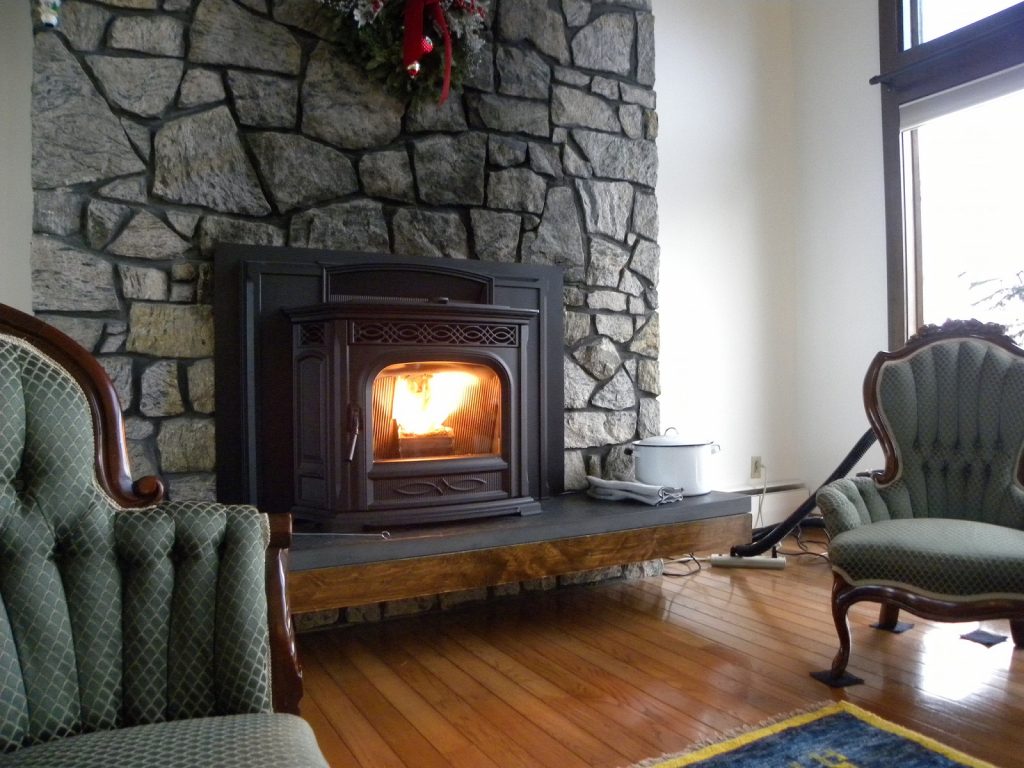
Do you use a pellet stove or are you thinking of using one? Well, you should. The stove offers a viable solution to warm your space. It is easy to set up and it will make your home cozier. Wondering why you haven’t heard or seen it before? Perhaps you could blame our dependence on electricity – yes, there is an alternative to wholly electric or gas heating systems.
I know what you are thinking: isn’t the use of wood in burning stove somewhat archaic? Well, not so and the surprising bit is that the pellets used in the stove actually help in lowering your carbon footprint. Interesting, isn’t it? Well, keep reading to learn more.
Table of Contents
Who Makes the Best Pellet Stove?
| Pellet Stove | British Thermal Unit | Max Space Coverage | Hopper Capacity | Availability |
|---|---|---|---|---|
Comfortbilt HP22 | 50,000 BTU | 2,800 square feet | 55 lbs | See Price |
Castle 12327 Serenity | 22,226 BTU | 1,500 square feet | 40 lbs | See Price |
Pelpro PP130 | 50,000 BTU | 2,200 square feet | 130 lbs | See Price |
Napoleon TPI35 | 38,250 BTU | 2,000 square feet | 45 lbs | See Price |
US Stove GW1949 Wiseway | 40,000 BTU | 2,000 square feet | 60 lbs | See Price |
What is a pellet stove?
Also called wood pellet stove or furnace-style fuel burners is just that – a stove that uses pellets to provide heat. You could think of it as a distinct heater that runs on wooden pellets rather than oil, wood, gas, or electricity.
Instead of burning huge chunks of wood, creating smoke in the process, these stoves generate warmth through the burning of small wooden pellets which are specially made for specific stove units.
This stove will burn biomass or compressed wood to generate all the heat you need to warm up your home.
What is pellet and why is it sustainable?
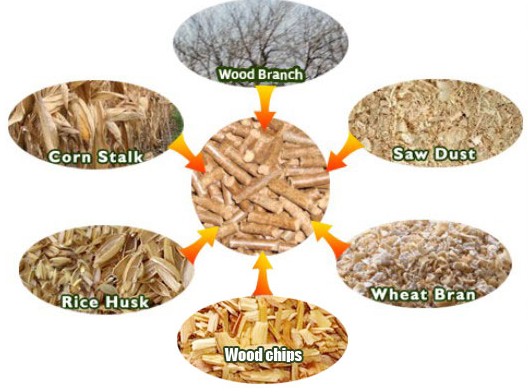
Pellets, the source of fuel for the stove refer to highly compressed and recycled biomass. The recycled and highly compressed biomass often comes from the lumber, food wastes, energy crops, industrial wastes and their co-products, or even agricultural residue.
However, the most common pellets for the stoves are from wood – compacted sawdust and other waste products from the lumber milling process. These pellets, are, therefore, biofuels.
The pellets are small and they have a general shape which makes it easy to shove them in the auger/ burner. The compression of the biofuel makes the pellets very dense – the result is a compact bag of pellet. The compact design also means that you don’t have to burn through a whole bag to feel the warmth from the heater.
Besides the small size, these pellets are sustainable because the pieces heat up slowly and produce a smokeless flame at the middle of the stove – think a smaller bonfire in contained space and with no smoke.
Furthermore, the pellets are cheaper and result in significant energy savings once set up. And with modern pellet-burning stoves having advanced controls for temperature, you will realize significant savings.
Being a recycled source of fuel, you don’t have to worry about the supplies running out as it is the case with fossil fuels, and to top it all, wood, like other plant materials is carbon neutral.
Lastly, with the best thermostat-regulated stove, you can control the use of this biofuel.
See video how wood pellets are made.
Storing Pellets
The pellet storage solution you choose will, to a large extent, determine the kind of stove you should get. The leading storage solutions including storage bins, bagging and the use of a hopper.
Storage bins are the simplest yet economical way to store pellets. You can use a wooden bin, trash bin or even tin buckets.
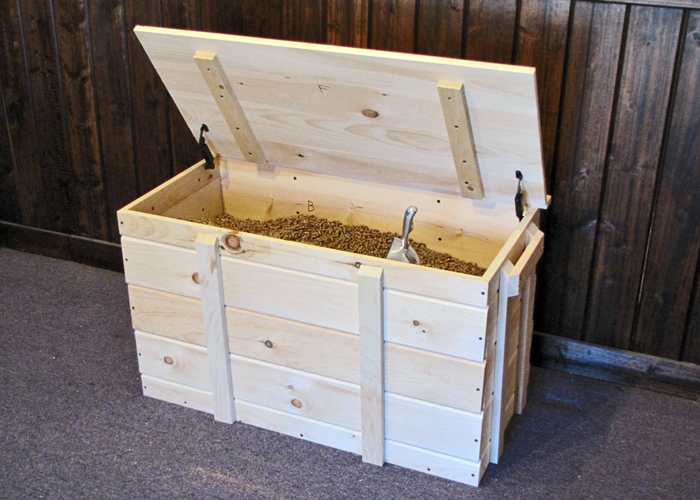
The use of hoppers is the most common storage solution for pellets when using pellet boilers and when holding the pellets before you fire it up.
Bagging is the next best alternative. The pellets fit in a 120kg bag and the bags will not take up much space. The bagged pellets are also cheaper than the ones in the hopper. Bagging the pellets is also less labor intensive.
Assuming you buy the pellets in bags, here is how to keep the pellets in perfect condition:
- Move the pellets from the bags into metallic and airtight buckets if you have buckets. The lid should be airtight at all times and also to pour from. Ensure that the bucket is weather resistant. An additional feature would be the presence of filter to get rid of any sawdust.
- If you don’t have buckets, the bag will work as long as you keep them dry.
- Avoid zip bags
- Keep the pellets in a dry area that is free from mold, humidity and flooding. We highly recommend storing the pellets indoors.
- If you have to store the pellets outdoors, keep them on a raised surface. You could use plastic bags as long as you check for holes or rips.
- Summer storage: keep the pellets away from any contact with water, dirt, leaves, and litter. Get high quality protective wraps if you do not have airtight buckets.
- Fall and winter storage: You should be getting ready to use the pellets. You should remove the protective wrap carefully but leave on the shroud as well as the tarp.
- Spring storage: keep the pellets covered if you still have some left from winter. You might want to clear out the hopper too.
Pellet Stoves: How do they work?
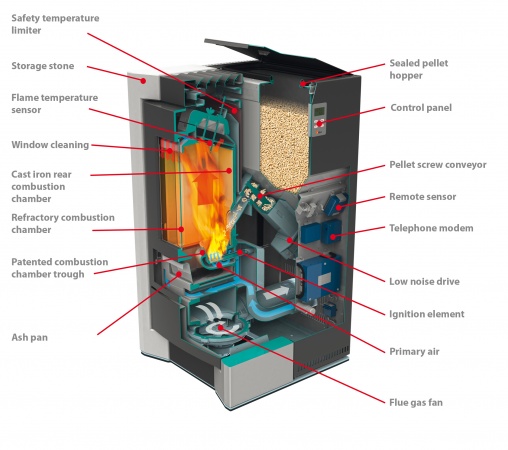
The stoves powered by pellets work differently than other types of heaters.
They have five main components: the fuel pellet hopper, auger, burn pot, electric blower, and a heat exchange. To understand how the stove works, take a look at the main parts of the stove.
- Pellet hopper: this is the part that holds the compressed biomass materials. Hoppers vary in size meaning that they hold varying quantities of pellets. Most of the stoves have hoppers that hold pellets ranging from 40lbs to 100lbs.
- Auger: driven by an electric motor, the auger turns and carries pellets from the hopper to the burning pot. Modern stoves have sensors in the stove. The sensors will notify the system when to turn the auger and when to add more fuel, depending on your heat settings.
- Burn pot: this is where the pellets go when the auger turns. Here, the fire remains small but extremely hot. The result is a stove burning at its maximum efficiency with little to no waste.
- Electric blower: the blower adds air to the fire ensuring that the pellets burn as hot and as efficiently as possible. After air is blown into the fire, the used air is vented. Note that the type of venting depends on the model of stove you buy.
- Heat Exchange: located above the heating compartment. The heat exchange is a series of pipes which will catch most, if not all the heat from within the stove. Some models have a fan to disperse the heat.
In summary, this is what happens: After loading the hopper with pellets, the auger transfers the pellets to the burn pot or the heating chamber. In the burn pot, you have an internal thermostat which will gauge the heat levels and then determine when more pellets should be added by the electric motor of the auger.
The air from the room enters the stove through a built-in stove fan the heat goes to the burn pot and from there, the heat is released back to the room or through the vent.
Pros and Cons of the Stove
Pros
- Highly efficient and they have an efficiency range of 70 to 83 percent. Also, the best heating stoves will have a high capacity of between 8000 and 100000BTU (British Thermal Units) per hour.
- Low smoke and toxic chemicals emission make these stoves eco-friendly. Unlike fossil fuels, wood, coal, and oil, pellets produce very low concentrations of greenhouse gases.
- Easy installation of the vent pipe
- They use sustainable and efficient fuel
- The stove runs autonomously
- Easy maintenance
- Clean burning of pellets
- The stove will not attract pests
- Highly economical
- Pellets require less storage space
- You can regulate the heat easily.
- The stove is safer
Cons
- You need electricity for the auger to work for the electric stoves
- The stove is a little noisy
- The stove is complex
- Not darn cheap
Cost, Installation and Maintenance
You can get the stove easily from most stores, including Amazon. They are not cheap compared to electric space heater, and most standard stoves range from $1000 to $3000. This price range makes the stove heftier than all the other sources of heat for homes.
According to HomeAdvisor, the average national price of the stoves is a little over $2000. The low-end models cost as low as $300 while the high-end models cost $4500.
The cost, will, however, go up a bit if you consider the cost of the pellets and the stove inserts. The cost of the pellets relies on the availability of wastes and the forces of supply and demand will affect the price. The current cost of the pellets ranges from $4 to $6 for every 40-pound bag.
When looking at the price of the pellets per bag, you also need to determine how many bags you will need to warm that room. That means the overall cost per day could go up or down depending on the outdoor conditions, size of the space, the building’s insulation, and the desired temperature.
You also have the stove’s insert – the appliance often installed in the regular fireplace turning it into a stove. The pellet stove inserts cost approximately $2000 and you may have to get a professional to install. You may also incur other costs associated with purchase of a new chimney, as well as sealing of gaps.
Installation
When shopping for a stove, you need to consider the capacity of the stove and the size of the room it has to heat up. This is because the stove is often used to heat up a single room. Even when you have central heating, the stove comes in handy as it may lower your energy bills.
To know how fast the stove will heat the space, take into account its BTU. The BTU also depends on the size of the room as well as insulation, window spaces, outdoor temperature, and the desired internal temperatures.
Installing a free-standing stove goes for anything from $250 to $600, and that only covers labor. Installing the vent could go for $600 – $800 and installing a heat-resistant and a non-combustible hearth pad cost you anything from $40 to $300.
As mentioned above, you also need to account for the stove’s fireplace insert, a chimney and sealing of gaps.
You should also take into account the cost of a carbon monoxide detector because you are burning wood. Other installation costs include the cost of a backup power supply, a mesh ash vacuum, and a vent brush.
Don’t forget the cost of electricity for the auger.
We advise against installing the stove as a DIY project.
Maintenance
Once you buy this stove, you should be ready for regular maintenance, especially if you use it heavily. You have to wash the ash pans daily after every use (daily or weekly). And with the few moving parts, you need to ensure that all the parts are in good working condition.
Besides dumping ashes out after use, you need to vacuum the fans and the ash pan weekly. You also have to brush the vents. And in the cold season, the igniter should be checked at least three times. Replacing the igniter costs $200.
After winter, clean it thoroughly and remove pellets from the hopper.
Make sure to use a professional to avoid failures resulting from poor installation or maintenance.
You also need to use the right type of fuel to avoid excess generation of ash which could clog up the fans and the blowers. So, if you have to use low-quality fuel, remove the ash frequently.
Pellet Stove vs Wood Stove
The difference between these two types of stoves is significant. First off, most of the wood stoves lack certification from the US Environmental Protection Agency (EPA) but most, if not all modern pellet-fueled stoves are EPA-certified.
While these two types of stoves look similar – they both have an insert and they are freestanding, and also work well in heating interiors and even sheds, the stoves that use pellets are far more efficient and they provide superior heating performance than the wood stoves. Also, the carbon emissions of the wood stoves are high.
The installation cost for the pellet heater is lower than that of the wood heater. While the cost of wood is lower than that of pellets (because of the use of electricity), the wood stoves are worse for the environment.
You may also want to know that the stoves that use pellets are safer than their counterparts using wood because the former feature an automatic shutdown, an exhaust sensing probe, and a pressure switch.
Venting options: your pellet burner emits little smoke and is has an exhaust drafted outside with a fan through a vertical or a horizontal venting pipe. On the other hand, the wood stove features a passive system that needs a vertical chimney for the smoke to rise through.
Storage of fuel: pellets should be kept indoors and guarded from moisture. However, you have to stack your wood outside in a covered place because of the risk of termites.
Heat produced: the stoves that use pellets produce more heat than the wood stoves. They have an overall efficiency of 90 percent.
Stove Styles
If you have been pushing off the purchase of the stove because of the confusing designs and models, we hope that this section helps you in differentiating the main types of stoves and also help you determine the stove that best meets your needs.
As you look for your perfect stove, you should know that there are freestanding stoves and stove inserts.
Freestanding stoves are just that – upright standing pellet-fueled stoves. They could be top-feed stoves, bottom-feed, and manual ignition stoves.
Top-feed stoves
The design of these stoves will let you pour pellets into the hopper from where the pellets travel down the chute to the stove. With this kind of construction, no debris will burn back into the hopper. The only catch is that the combustion chamber (burn pot) easily clogs up with clinkers and ash. You can, however, overcome this challenge by buying high-quality pellets.
Bottom-feed stoves
As the name suggests, you place the pellets at the bottom. This means that you don’t have to worry about clogging because the clinkers and the ashes go to the ash pan. The main problem is that they are less efficient when compared to the top-feed stoves. They are also complex.
Manual ignition
These stoves require a starter material lit using a flame. The ignition material could be a liquid or a gel. Such stoves have start burns and as soon as you push the ignition button, pellets are fed into the burn pot heating the self-igniter.
On the other hand, you have the stove inserts. The insert goes into the fireplace and you don’t have to buy an entire stove for a warm and cozy room!
The 5 Best Wood Pellet Stoves
Comfortbilt HP22 – Best Stove for Large Homes
Topping our list of the best stoves using pellet is this masterpiece by Comfortbilt. This Comfortbilt HP22 is a powerful stove that emits up to 50,000BTU, sufficient to heat from 800 square feet up to 2800 square feet space.
In case you are wondering, the BTU rating (British Thermal Units) refers to the measure of the stove’s heat output. It represents the amount of heat necessary to raise the temperature of one pound of water at room temperature by one-degree Fahrenheit. What this means is that your Comfortbilt HP22 delivers 50,000 BTU output into your home.
But, power is not all that the stove boasts, it promises a high level of burning efficiency – 86 percent. The powerful blower ensures that the pellets burn out completely. This efficiency makes the stove a great energy saver. For improved efficiency, this stove has a 55 lbs hopper capacity and it has an auto ignition system of operation.
The programmable thermostat lets you set the desirable temperatures expected while preventing further burning of pellets once the desired temperature is attained.
 It also comes with an ash pan. Knowing how much ash can accumulate and eventually clog the burn pot, Comfortbilt knows that you need a reliable system of cleaning the stove, hence the high-quality ash pan.
It also comes with an ash pan. Knowing how much ash can accumulate and eventually clog the burn pot, Comfortbilt knows that you need a reliable system of cleaning the stove, hence the high-quality ash pan.
Comfortbilt HP22’s large viewing area, the bay design and the carbon black finish make this stove the best heating system for your home, regardless of the style of your home’s interior. Besides warming the house, this stove will also spruce up your space.
Its EPA certification ensures that you keep your carbon as low as possible. Since the pellets are almost carbon neutral, you could boast of living in a green home.
Specifications
- EPA certified
- 110 volt auger
- 86 percent efficiency
- 50,000 BTU for 2800 square feet
- 1-year warranty on parts.
- 295 lbs
- 55 lbs hopper capacity
- Maximum burn time of 24 hours
- Ash pan, auto ignition, and programmable thermostat.
- It has a large viewing area
- Its design adds flair to your home
- It has a high heating capacity
- The powerful blower provides 86 percent thermal efficiency
- It is EPA-certified
- Durable materials and design
- Easy to use and maintain
- Burns quietly
- The glass door doesn’t get foggy
Cons
- No shipping to Alaska, Puerto Rico or Hawaii.
- Not easy to operate
Castle 12327 Serenity – Sleek Design for Small Areas

Regarded as one of the best stoves out there, this Castle 12327 Serenity by Castle Pellet Stoves boasts an air of sophistication seen in its sleek and modern design.
Among other features, the smart controller is the most prominent and arguably the most powerful feature. This smart controller stays true to its description by allowing you a wide range of control systems.
You could use the smart controller to choose the manual setting, use of a thermostat, and you could also choose the weekly operational mode for heating your home as per your schedule.
The controller also comes with a calendar and a time-based heating option. To top it all, you could use the controls to set your local thermostat. Alternatively, you could set the thermostat manually to one of the five burn levels provided.
Unique design: the smart controller isn’t everything that makes the stove an excellent choice. You also have to look at its impressive design. Designed to save money while looking good, this Castle 12327 is a great addition to any home.
 The unit brings a good value for your money and is practical. Its ease of use and easy to clean design comes from the fact that this stove has no hidden chambers, no corrugations, and no tubes.
The unit brings a good value for your money and is practical. Its ease of use and easy to clean design comes from the fact that this stove has no hidden chambers, no corrugations, and no tubes.
Wondering how efficient the stove is? Well, it is efficient but not as efficient as Comfortbilt HP22. Castle 12327 has a 69.8 percent thermal efficiency. Although it’s cheaper than our best stove and it only covers 1500 square feet.
You might also like the stove design as it makes it easy to install. Castle 12327 Serenity is compact and fits in small spaces easily.
Specifications
- EPA-certified, ETL certified, and Mobile Home Certified
- 24-hour smart programmable controller
- 120 volt plug in
- 22,226 BTU Output; 31,960 BTU Input
- 69.8 percent thermal efficiency
- 24-hour burn time on low setting and 12-hour burn time on the high setting
- 1500 square feet coverage
- 40 lbs pellet capacity in the hopper
- Dimensions: 23.75 D x 34 H x 18.25 W
- Exhaust 3 inches
- Weight 186 lbs
- Adjustable thermostat
- Eco-friendly
- Easy to use
- Cleaning is a breeze
- Virtually no smoke
- Sleek and attractive design
- Reliable and Good value for money
- Efficient
- Simple and intuitive controls
Cons
- The hopper is small
- Less efficient than competition
- It is loud
- You cannot switch off the backlight
- No ash pan.
Pelpro PP130 – Boasts a Large Hopper Capacity
We know that if you are going to buy a wood pellet-powered stove, you will want that it doesn’t break the bank and also one that will lower your energy costs in the long run, right?
Well, that means that you will like this Pelpro PP130 by Pelpro. With a remarkable 86.5 percent thermal efficiency, this stove pushes other stoves out of the path to the top.
Besides it high efficiency, it easily heats up as much as 2200 square feet of space and it has a high burn time of 80 hours. The long burning hours result from its 130 lbs hopper capacity – larger than Comfortbilt HP22 and Castle 12327 Serenity. Why is it not on top of the list? Well, it doesn’t heat up as much as space as the Comfortbilt HP22.
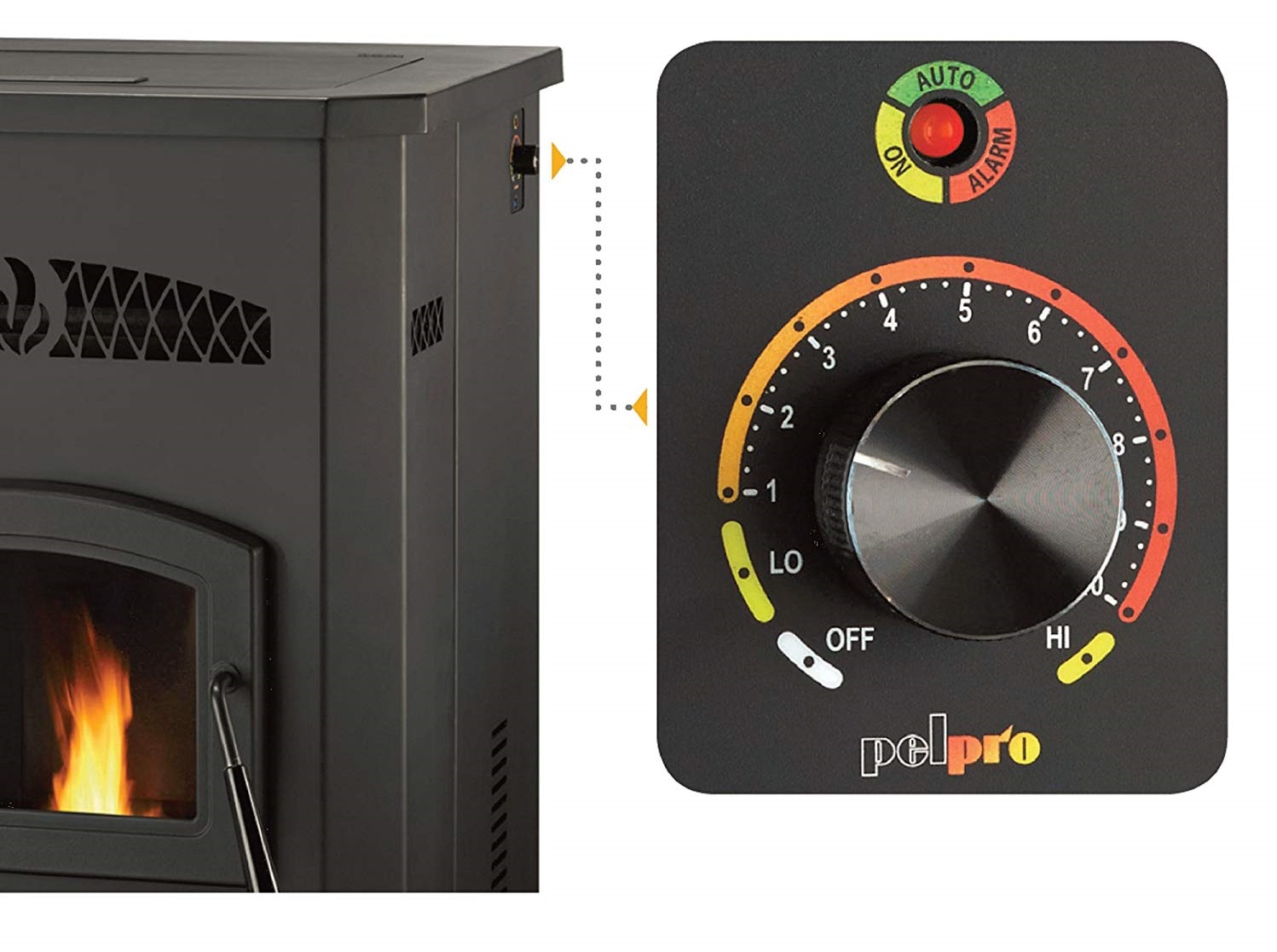 For ease of use, it boasts 3 heat settings for you to adjust as per your needs. It also boasts an intuitive control system and an auto-ignition system for easy control of the heat.
For ease of use, it boasts 3 heat settings for you to adjust as per your needs. It also boasts an intuitive control system and an auto-ignition system for easy control of the heat.
Its 50,000 BTU make it as powerful as its competitors. Only issue is: from our research, it doesn’t work well for too long.
Specifications
- Dimensions: 22.8 x 24.5 x 36.5 inches
- 86.5 percent thermal efficiency
- 120 volts
- 5 thermal efficiency
- 130 lbs hopper capacity
- Heating capacity of 2200 sq. ft.
- 80 hours burning time
- Comes with a blower, and thermostat
- 3 heat settings
- 3-inch flue collar
- Long burning time
- Efficient
- Easy installation
- Covers a large space
- Easy to use
- Comes with a blower
Cons
- Breakdown too soon
- No ashpan
- The motor burns out fast
- The large hopper means it takes up a large space
Napoleon TPI35 – Best Pellet Stove Insert
 If you’d like to convert your fireplace into a pellet burner, then you should look for the best pellet burner insert. And, this Napoleon TPI35 meets all your needs effectively
If you’d like to convert your fireplace into a pellet burner, then you should look for the best pellet burner insert. And, this Napoleon TPI35 meets all your needs effectively
Unlike other stoves, this stove uses a 50 percent mix of pellets and corn. It has a 45 lbs hopper and a wide range of BTU from 8000 to 38,250.
This stove insert boasts a black door adorned with air wash. The door and its finish give the insert an elegant feel. For ease of use, it comes with digital control panel, auto ignition, and a heat exchange. It has a 120 CFM convection which enhances its efficiency.
You will also like the thermostatic control that gives you control over the temperature you desire for your home.
Specifications
- 120 CFM convection fan
- 2,000 square feet space coverage
- 76.3% efficiency rating
- 50 percent mix of corn and pellets compatible
- 45 lbs hopper
- Thermostatic control
- Digital control panel
- 8,000 – 38,250 BTU
- Fireplace opening: 22″w x 21″h.
- Weight: 140 lbs
- 2-inch air intake at the rear
- 120v Plug in
- Fits the fireplace easily
- Easy to use
- Efficient
- Heats up as much as 2100 square feet
- Intricate and sleek design
Cons
- Venting is necessary during installation
- Small hopper
- Relatively expensive
US Stove GW1949 Wiseway – Electricity-Free Operation
 Are you looking for a non-electric pellet-fueled stove? Perhaps this US Stove GW1949 Wiseway is what you are looking for.
Are you looking for a non-electric pellet-fueled stove? Perhaps this US Stove GW1949 Wiseway is what you are looking for.
It has an intricate unique design which differentiates it from all the other stoves reviewed above. But, how does it work if it is not powered by electricity? Well, the stove is an EPA-Certified stove which uses a natural gravity feeding system. This system results in low maintenance and its ability to heat up as much as 2,000 square feet of space.
Note that the natural gravity feeding system will replace and eliminate the mechanical parts making more durable than the other stoves reviewed above.
Since it does not use electricity, it makes use of the 3 1/2-inch tubing to radiate heat away. The steel baffles at the back also radiate the heat away. The best bit is that this US Stove GW1949 Wiseway is easy to start and operate.
 To start it, heat up the burn pot and the flue and then start the flow of the pellets using a propane torch. Its natural ramp will take over once the pellets start burning and it also ramps it up to your desired temperature.
To start it, heat up the burn pot and the flue and then start the flow of the pellets using a propane torch. Its natural ramp will take over once the pellets start burning and it also ramps it up to your desired temperature.
It provides 40,000 BTUs and it makes use of the standard 3-inch pellet venting system. This venting system increases its efficiency. The 60-pound hopper capacity gives the stove a 36-hour burn time. All the while, this modern stove burns silently.
Installation is made easy by the small clearance at the rear as well as the sides of the wood pellet stove.
So, if you live in a place prone to blackouts, this US Stove GW1949 Wiseway promises to end your cold nights.
You can adjust the temperature by opening or closing the fresh air intakes located the front of the stove.
Specifications
- Easy-to-read thermometer
- 75 percent thermal efficiency
- Glass viewing window
- 40,000 BTU
- 3 1/2 tubing for radiation at the back
- Dimensions: 15 x 52 x 24 inches
- Weight: 13 lbs
- 2000 sq. ft.
- 60 lbs hopper with 36 hours burning time
- EPA certified
- UL Listed
- You can see the flame traveling up the stove thanks to the glass viewing window
- Easy to use
- Simple installation
- It doesn’t use electricity
Cons
- You cannot brick it to retain more heat
- Unsuitable for cold northern climates
- Few draft issues
Wrapping Things Up: Pellet Stoves – Are They Worth Your Money?

Finding the pellet stove that works well for your home is not simple with all the options flooding the market. However, you can easily narrow down your options by considering the climate of the place you live during the cold months, then size of your home, type of insulation used for your home, desired temperature, and the stove’s BTU.
You also need to take into account the size of the hopper: although this doesn’t affect the overall efficiency of the stove, it determines how long the stove burns before you have to refill the hopper. Type of fuel used, the need for electricity, size of the stove, cost and maintenance also determine the best stove.
From our reviews, the best stove is the Comfortbilt HP22. Its high efficiency, BTU, and its capacity to warm close to 3000 square feet make it a great heating solution.



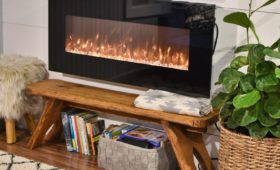
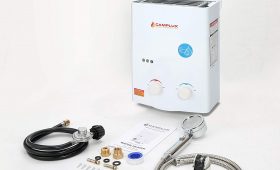

Very good information, was looking for pellet bags but learned a lot about how they should be stored etc
Very informative article. Just this season switching from wood burner to pellet burner heating. No more logs to pack. Can’t wait till delivered and set up